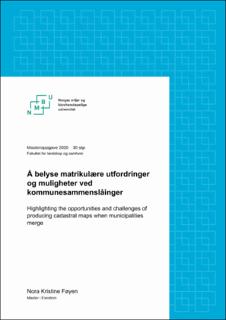| dc.contributor.advisor | Hegstad, Einar | |
| dc.contributor.author | Føyen, Nora Kristine | |
| dc.coverage.spatial | Norway | en_US |
| dc.date.accessioned | 2021-01-12T20:49:21Z | |
| dc.date.available | 2021-01-12T20:49:21Z | |
| dc.date.issued | 2020 | |
| dc.identifier.uri | https://hdl.handle.net/11250/2722656 | |
| dc.description.abstract | Denne oppgaven handler om «Å belyse matrikulære utfordringer og muligheter ved kommunesammenslåinger». Regjeringens intensjon med kommunesammenslåingene var å få mer robuste kommuner som kunne gi et bedre tilbud til innbyggerne. Kommunenes oppgave var blant annet å rette like adressenavn, like adressekoder, gårdsnummerserier, avvik i systemene; matrikkelen og grunnboken, og andre matrikulære oppgaver. For å belyse problemstillingene er det ved bruk av kvalitative metoder som dybdeintervju og dokumentanalyse. Hensikten var å få frem kommunenes, de store brukere av matrikkelen og Kartverkets erfaringer fra kommunesammenslåingene i 2020. Hvilke utfordringer og muligheter det medførte for nevnte aktørene. Oppgaven har tre delproblemstillinger som skal besvares:
1. Matrikulære utfordringer og muligheter for kommuner ved kommunesammenslåingene.
2. Utfordringer og muligheter store brukere har opplevd som følge av kommunesammenslåingene.
3. Kartverket sine erfaringer i forhold til matrikulære utfordringer ved kommunesammenslåingene.
I teoridelen vil det være gjennomgang av begrepene matrikkelen og adressesystemet, og Kartverkets sjekkliste vil bli nærmere belyst. Teorigrunnlag om eldre kommunesammenslåinger som skjedde 1. januar 2017 og 1. januar 2018 vil også bli beskrevet ut ifra kommunenes erfaringer med sammenslåingene.
Resultatene fra empiridelen og drøftelse viser at det var en del utfordringer som oppstod ved kommunesammenslåinger som eksempelvis at adresseringsprosessen tar tid. Mange kommuner er ennå ikke i mål med adressering. Betydningen av nesten like adressenavn er omdiskutert. Retting av feil i matrikkelen er omfattende og krevde betydelige ressurser og kunnskap. Store brukere ønsker mer informasjon knyttet til endringene som kommunene har gjort, noe som Kartverket har opplevd angående antallet endringene. Kommunikasjondelen er en viktig faktor under kommunesammenslåingene. | en_US |
| dc.description.abstract | This paper is about “Highlighting the opportunities and challenges of producing cadastral maps when municipalities merge”.
The intention behind the government’s decision to merge municipalities was to make municipalities more robust, thereby, strengthening their ability to provide a better service to their citizens. The municipalities were tasked with correcting identical address names, identical address codes, farm number series, tackle deviations in systems such as, the Cadastre and Land Registry, amongst other tasks. The methodology used to illustrate the issues are a qualitative method including in-depth interviews and document analysis.
The purpose was to bring forth the experience gained by the municipalities, the largest users of the Land Registry and Cadastre, during their involvement in the municipality mergers of 2020 and identify the resulting opportunities and challenges posed to them by these mergers. This paper addresses three sub-issues:
1. Opportunities and challenges in cadastral surveying caused by the merger of municipalities
2. Opportunities and challenges experienced by large/frequent users resulting from the merger of municipalities
3. The Land Registry’s experience with the challenges in cadastral surveying stemming from the merger of municipalities
A theoretical review of the concepts of the Cadastre and Land Registry systems is presented, as well as the Land Registry’s Mapping Checklist being explored in detail. A theoretical foundation is also described, from the municipalities’ point of view and experience gained from past mergers, which occurred between January 1st 2017 and January 1st 2018.
The empirical results and discussion show that challenges arose because of the municipalities merging, for example that the alignment of Addresses takes time. Many municipalities have not yet begun the process of aligning Addresses. The interpretation of ‘almost identical address names’ is disputed. Correcting cadastral surveying errors is extensive and requires considerable resources and skills. Given the high number of changes made, the Land Registry has experienced that the large/frequent users of the system want more detailed information related to the changes performed by the municipalities. Communication is a crucial factor during the merger of municipalities. | en_US |
| dc.language.iso | nob | en_US |
| dc.publisher | Norwegian University of Life Sciences, Ås | en_US |
| dc.rights | Attribution-NonCommercial-NoDerivatives 4.0 Internasjonal | * |
| dc.rights.uri | http://creativecommons.org/licenses/by-nc-nd/4.0/deed.no | * |
| dc.subject | Kommunesammenslåinger | en_US |
| dc.subject | Matrikkel | en_US |
| dc.subject | Muligheter | en_US |
| dc.subject | Utfordringer | en_US |
| dc.subject | Adresser | en_US |
| dc.title | Å belyse matrikulære utfordringer og muligheter ved kommunesammenslåinger | en_US |
| dc.title.alternative | Highlighting the opportunities and challenges of producing cadastral maps when municipalities merge | en_US |
| dc.type | Master thesis | en_US |
| dc.subject.nsi | VDP::Samfunnsvitenskap: 200 | en_US |
| dc.source.pagenumber | 160 | en_US |
| dc.description.localcode | M-EIE | en_US |

